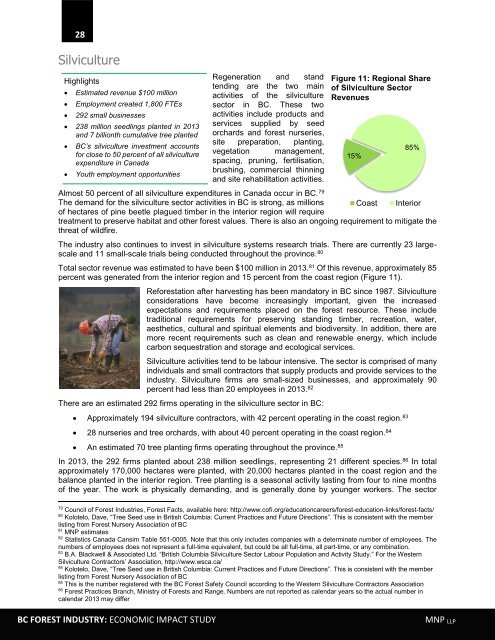bc-forest-industry-economic-impact-study
bc-forest-industry-economic-impact-study
bc-forest-industry-economic-impact-study
You also want an ePaper? Increase the reach of your titles
YUMPU automatically turns print PDFs into web optimized ePapers that Google loves.
28<br />
Silviculture<br />
Highlights<br />
<br />
<br />
<br />
Estimated revenue $100 million<br />
Employment created 1,800 FTEs<br />
292 small businesses<br />
238 million seedlings planted in 2013<br />
and 7 billionth cumulative tree planted<br />
<br />
<br />
BC’s silviculture investment accounts<br />
for close to 50 percent of all silviculture<br />
expenditure in Canada<br />
Youth employment opportunities<br />
Regeneration and stand<br />
tending are the two main<br />
activities of the silviculture<br />
sector in BC. These two<br />
activities include products and<br />
services supplied by seed<br />
orchards and <strong>forest</strong> nurseries,<br />
site preparation, planting,<br />
vegetation management,<br />
spacing, pruning, fertilisation,<br />
brushing, commercial thinning<br />
and site rehabilitation activities.<br />
<br />
Almost 50 percent of all silviculture expenditures in Canada occur in BC. 79<br />
The demand for the silviculture sector activities in BC is strong, as millions<br />
of hectares of pine beetle plagued timber in the interior region will require<br />
Coast Interior<br />
treatment to preserve habitat and other <strong>forest</strong> values. There is also an ongoing requirement to mitigate the<br />
threat of wildfire.<br />
The <strong>industry</strong> also continues to invest in silviculture systems research trials. There are currently 23 largescale<br />
and 11 small-scale trials being conducted throughout the province. 80<br />
Total sector revenue was estimated to have been $100 million in 2013. 81 Of this revenue, approximately 85<br />
percent was generated from the interior region and 15 percent from the coast region (Figure 11).<br />
Re<strong>forest</strong>ation after harvesting has been mandatory in BC since 1987. Silviculture<br />
considerations have become increasingly important, given the increased<br />
expectations and requirements placed on the <strong>forest</strong> resource. These include<br />
traditional requirements for preserving standing timber, recreation, water,<br />
aesthetics, cultural and spiritual elements and biodiversity. In addition, there are<br />
more recent requirements such as clean and renewable energy, which include<br />
carbon sequestration and storage and ecological services.<br />
Silviculture activities tend to be labour intensive. The sector is comprised of many<br />
individuals and small contractors that supply products and provide services to the<br />
<strong>industry</strong>. Silviculture firms are small-sized businesses, and approximately 90<br />
percent had less than 20 employees in 2013. 82<br />
There are an estimated 292 firms operating in the silviculture sector in BC:<br />
Approximately 194 silviculture contractors, with 42 percent operating in the coast region. 83<br />
28 nurseries and tree orchards, with about 40 percent operating in the coast region. 84<br />
An estimated 70 tree planting firms operating throughout the province. 85<br />
Figure 11: Regional Share<br />
of Silviculture Sector<br />
Revenues<br />
In 2013, the 292 firms planted about 238 million seedlings, representing 21 different species. 86 In total<br />
approximately 170,000 hectares were planted, with 20,000 hectares planted in the coast region and the<br />
balance planted in the interior region. Tree planting is a seasonal activity lasting from four to nine months<br />
of the year. The work is physically demanding, and is generally done by younger workers. The sector<br />
15%<br />
85%<br />
79<br />
Council of Forest Industries, Forest Facts, available here: http://www.cofi.org/educationcareers/<strong>forest</strong>-education-links/<strong>forest</strong>-facts/<br />
80<br />
Kolotelo, Dave, “Tree Seed use in British Columbia: Current Practices and Future Directions”. This is consistent with the member<br />
listing from Forest Nursery Association of BC<br />
81<br />
MNP estimates<br />
82<br />
Statistics Canada Cansim Table 551-0005. Note that this only includes companies with a determinate number of employees. The<br />
numbers of employees does not represent a full-time equivalent, but could be all full-time, all part-time, or any combination.<br />
83<br />
B.A. Blackwell & Associated Ltd. “British Columbia Silviculture Sector Labour Population and Activity Study.” For the Western<br />
Silviculture Contractors’ Association, http://www.wsca.ca/<br />
84<br />
Kolotelo, Dave, “Tree Seed use in British Columbia: Current Practices and Future Directions”. This is consistent with the member<br />
listing from Forest Nursery Association of BC<br />
85<br />
This is the number registered with the BC Forest Safety Council according to the Western Silviculture Contractors Association<br />
86<br />
Forest Practices Branch, Ministry of Forests and Range. Numbers are not reported as calendar years so the actual number in<br />
calendar 2013 may differ<br />
BC FOREST INDUSTRY: ECONOMIC IMPACT STUDY<br />
MNP LLP


